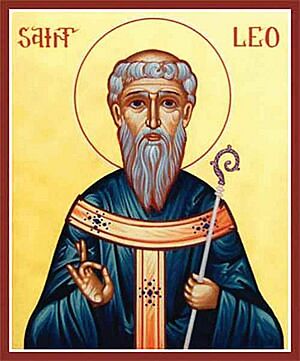Leo of Catania facts for kids
Quick facts for kids SaintLeo |
|
|---|---|

Icon of Saint Leo of Catania
|
|
| Bishop of Catania Confessor Wonderworker |
|
| Born | c. 703 or 709 Ravenna, Exarchate of Ravenna |
| Died | 789 Catania, Theme of Sicily |
| Venerated in | Roman Catholic Church Eastern Orthodox Church Anglican communion Lutheranism |
| Feast | February 20 |
Saint Leo of Catania, also known as St Leo the Wonderworker, was an important bishop in the city of Catania, Sicily. He lived from about 703 or 709 until February 20, 789. He was the fifteenth bishop of Catania and was well-known for his kindness and care for people who were poor.
His feast day is celebrated on February 20, the day he died. Both Roman Catholics and the Orthodox Church honor him as a saint. Leo lived during a time when there were many changes in the Byzantine Empire, which was a powerful empire in the East.
Saint Leo worked hard to fight against paganism (worshipping many gods) and sorcery (using magic for bad purposes). These practices were still common in Byzantine Sicily during his time. He became famous for his amazing and charitable actions. People in Catania even called him Leone "il Maraviglioso" which means "Leo the Wonderful." He is the patron saint of several towns in Sicily, including Rometta, Longi, and Sinagra.
Life of Saint Leo
Leo was born in Ravenna, a city that was then part of the Byzantine Empire. When he was young, he became a Benedictine monk. Later, he moved to Reggio Calabria in Southern Italy. There, the local bishop, Cyril, made him an archdeacon. An archdeacon is a senior church official.
Leo stayed in Calabria until he was chosen to be the new bishop for the Archdiocese of Catania. This city was almost 300 kilometers away. A local story says that the people of Catania, who needed a new bishop, all dreamed that an angel told them to go to Reggio. The angel said they would find a very holy man there.
At first, Leo did not want the job. He felt he was not worthy and politely said no. But eventually, he must have changed his mind. Whether the story is true or not, Leo did become the bishop of Catania in 765. He then began to serve the Christians in the city.
During Leo's time as bishop, a period called the Byzantine Iconoclasm began. This was a time when many sacred images and icons were fiercely destroyed across the Byzantine Empire. Catania and all of Sicily were part of this empire. Leo was very brave in speaking out against this destruction. Because of his opposition, the Byzantine governor of Sicily ordered his arrest. This forced Leo to leave Catania and find safety on the Tyrrhenian side of the island.
For many years, he traveled through the woody Nebrodian heights, between Longi and Sinagra. It seems that people helped him because they saw him as a strong protector against unfair imperial rule. His long travels eventually brought him to Rometta. Here, near Monti Peloritani behind Messina, he made a cave for himself by digging with his own hands. When the danger of being arrested passed, he returned to Catania to take back his role as bishop. With new energy, he continued to defy the iconoclast order. He also fought against false teachings that had started in his diocese. Saint Leo died in Catania on February 20, 789.
A Catanian Legend: The Wonderworker and the Sorcerer
There is a famous local story about Saint Leo and a man named Heliodorus. Heliodorus was a noble from Catania who had wanted to become bishop but was not chosen. Perhaps he felt angry and jealous that Leo, a man from far away, was picked instead. Heliodorus then turned away from the Christian faith. He started to practice magic and the occult to impress people and gain followers.
The story says that Saint Leo tried many times to peacefully convince Heliodorus to stop his devilish work. One Sunday in 778, Leo was leading a church service in Catania's main church. It is said that Heliodorus suddenly burst in, making a lot of noise. He walked through the church, trying to cast spells on the people. Some versions of the story say he appeared as a black elephant inside the church.
Leo had to stop the service to deal with the disturbance. He left the altar and pushed through the crowd to face Heliodorus. Leo challenged him to show everyone who was truly right. The legend then moves to the nearby Achillean Thermal Baths, where the Catania Cathedral now stands.
The story claims that Leo ordered wood to be piled up and set on fire inside the baths. Then, Leo suddenly wrapped his Omophorion (a special bishop's scarf) around Heliodorus. He dragged Heliodorus into the tall flames. Both men were swallowed by the fire, and their clothes turned to embers. But only Leo survived. His body was unharmed, and his vestments looked perfect and shiny. All that was left of Heliodorus was smoking ashes.

